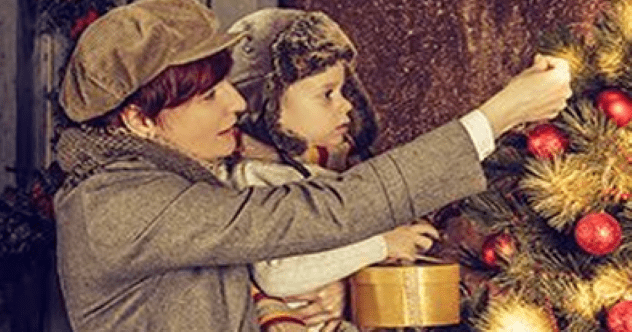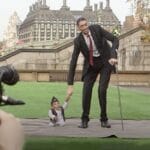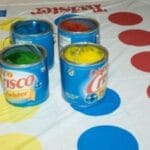A century ago, folks in the Roaring Twenties loved Christmas just as much as we do. But boy, how things have changed! While the Christmas spirit remains, the way we celebrate has seen some big shifts. Both the 1920s and the 2020s kicked off after worldwide health crises, making us look for comfort and joy in traditions. So, let’s hop in our time machine and see what Christmas looked like for the flappers and fellas back then compared to our world today. Grab your eggnog, and let’s explore!
Santa Hasn’t Changed Much!
If you peek at Christmas photos from the 1920s, you’ll notice the old-timey clothes and black-and-white pictures. But guess who looks almost the same? Good old Santa Claus! He still had his long white beard, a cheerful smile, and a round tummy. His red suit with white trim was already his signature look. Back then, many people also called him Father Christmas, mixing American and English traditions.
In the Roaring Twenties, Santa was quite the modern guy. He’d sometimes show up for events in an airplane, like he flew straight from the North Pole! Instead of elves, little helpers dressed as “Eskimos” (a term we don’t use today) often joined him in parades. Santa was even a star in ads, selling things like cigarettes or fizzy water, which was popular for mixing drinks during Prohibition. Department store Santas, like those at Macy’s, were already a big hit, creating magical “Santalands” for kids. Today, being a professional Santa can be a good job, with some making a lot of money spreading cheer!
Who Was Part of Santa’s Team?
The very first Macy’s Thanksgiving Day Parade, then called a Christmas Parade, happened in 1924. Santa made his grand entrance on a sleigh, pulled by horses dressed as reindeer. But his famous elves weren’t often seen in costume during the 1920s. Famous artist Norman Rockwell painted them as tiny figures in 1922. It wasn’t until movies and TV showed people playing elves that we started thinking of them as child-sized helpers.
Mrs. Claus was already a beloved part of Christmas stories by the 1920s. Reindeer like Dancer, Prancer, and Donner were also known. However, Rudolph the Red-Nosed Reindeer didn’t join the team until 1939, and Frosty the Snowman much later in 1950. A popular winter character back then was Jack Frost. He was a playful spirit who brought cold weather and nipped at noses, often appearing in Christmas tales and poems.
Giving Gifts: Then and Now
A hundred years ago, kids writing to Santa might ask for different things. A boy might want a sled, a BB gun, a toy train, or newfangled Tinkertoys. A girl might hope for a doll, doll clothes, a dollhouse, or a little red wagon. Moms with electricity in their homes wished for new gadgets like vacuum cleaners or toasters. Dads often got practical gifts like socks or tools – some things never change!
Fancy wrapping paper like we use today was quite pricey back then. Most families wrapped gifts in cheaper tissue paper. Since tape wasn’t invented yet, they used string or special gummed seals with holiday designs called “Christmas Seals.” These presents were placed under big, bushy Christmas trees that were often as wide as they were tall. Today, kids’ gifts are often less tied to gender, with LEGOs and cool robots popular for everyone. Teens love tech gadgets, and thankfully, Amazon can bring them right to our door, though not down the chimney!
A Very Dickens Christmas
If you flipped through a 1920s cookbook, you’d find recipes for a grand Christmas dinner. Think roast duck with plum pudding, much like in Charles Dickens’s stories. After World War One and the Spanish flu, people longed for simpler, cozier times. This led to a big wave of nostalgia for a Victorian-style Christmas. Sprigs of holly became popular decorations, and images of top hats and geese filled holiday designs.
Interestingly, this perfect Victorian Christmas was more of a dream than reality, even in England. But it had a wonderful, warm feeling. People started caroling in groups, a tradition that Dickens helped make popular again. Fast forward to our times, after another pandemic. We’re seeing trends like putting up decorations earlier and going all out. Black Friday sales now seem to start right after Halloween. Perhaps big and bold is our new version of cozy nostalgia.
Holiday Cheers on the Airwaves
Today, we can watch Christmas specials on TV or stream endless holiday movies. Think of classics like It’s a Wonderful Life or How the Grinch Stole Christmas. But a century ago, there was no television! Families gathered around the radio for evening entertainment. Christmas music like “Adeste Fideles” filled homes with holiday spirit.
Holiday parties in the 1920s often centered around the fancy radio. Guests enjoyed tasty snacks like deviled eggs or sandwiches made with the new Wonder Bread. Eggnog powder was available to mix with milk – or perhaps with a bit of rum, since Prohibition was in effect! Red Jell-O was a special Christmas treat. Readings of A Christmas Carol were very popular on the radio, fitting the Victorian Christmas trend. The story was even made into movies four times during the 1920s!
Singing Christmas Carols
Besides the radio, folks in the 1920s had phonographs, which were early record players. But there weren’t many Christmas records available. Pianos were more common in homes. A Christmas party with a piano was a real treat! Guests would sing songs like “The Twelve Days of Christmas” together, maybe while sipping some bubbly and trying new desserts like pineapple upside-down cake.
People loved making their own music, so caroling became a big Christmas tradition. Charles Dickens’s stories also inspired groups to go singing door-to-door. Popular carols included “Silent Night,” “Jingle Bells,” and “Auld Lang Syne.” Carolers were often welcomed with warm drinks. Times have changed! Caroling is pretty rare now. We don’t need to make our own music when there are hundreds of thousands of Christmas songs available to stream anytime, anywhere.
The Fruitcake Joke Endures
In the 1920s, Christmas dessert tables featured yummy treats like butterscotch cake and raisin pie. And often, off to the side, sat a heavy fruitcake – usually laughed at and maybe even passed on as a gift! Mass-produced fruitcakes in the early 1900s used cheap ingredients. Plus, Prohibition meant no whiskey, a key ingredient for a good fruitcake. The saying “nuttier than a fruitcake” even started around this time.
A hundred years later, we’re still joking about fruitcake! There’s even an annual fruitcake toss event in Colorado. And December 27th is National Fruitcake Day, though it’s mostly for fun. It seems fruitcake humor isn’t going away. But maybe fruitcake doesn’t have to be bad. The British make delicious ones with good ingredients. Perhaps it’s time we tried their version instead of just tossing ours!
The Great Holiday Debate
We often hear debates today about saying “Happy Holidays” versus “Merry Christmas.” It might seem like a modern issue, but arguments about Christmas aren’t new. Back in 1921, famous businessman Henry Ford publicly complained that Christmas was becoming too non-religious. He pointed to holiday cards without religious themes and made some very offensive remarks, causing a big stir.
A century later, these kinds of discussions continue. We’ve seen arguments over school pageants and Nativity scenes in public places. You might hear phrases like “Keep Christ in Christmas.” Sometimes Christmas parties are renamed “winter celebrations.” These debates about the meaning and celebration of Christmas have been around for a long time and don’t seem to be fading, much like our friend, the fruitcake joke. It’s a shame for a holiday that’s meant to be about peace.
The Christmas Tree Transformed
Christmas trees in the 1920s looked quite different from today’s perfectly shaped ones. They were often short and very bushy, sometimes wider than they were tall! People decorated them with glass ornaments, festive cardboard shapes, small toys, and even strings of animal cracker boxes. A beautiful but very flammable type of tinsel was also draped on the branches.
Little Christmas villages or nativity scenes, sometimes called Putz houses, were popular under the tree. Artificial trees made from goose feathers, often from Germany, also became fashionable. These sometimes had red berries that cleverly held candles! Today, our Christmas is much safer with flame-retardant tinsel. Many people now choose artificial trees over real ones. While these are often flame-retardant, we now worry about electrical fires from pre-lit trees. It seems keeping the tree safe is always on our minds!
Decking the Halls, Then and Now
In the Roaring Twenties, families usually put up their Christmas tree right before Christmas, often on Christmas Eve. Stringed lights were costly, and many homes didn’t even have electricity at the start of the decade. So, lighting real candles on the tree was the main option. People knew this was risky, so candles were lit only briefly, with a bucket of water nearby!
Stockings were actual socks, filled with fruit, nuts, candy, and small toys. Kids found them hanging from a doorknob or bedpost, not the fireplace, as fireplaces were usually roaring with a fire to heat the home. Outdoor decorations were simple and unlit – maybe some green boughs or a wreath on the door. But things began to change in the mid-1920s when a company called NOMA started making safer and cheaper electric Christmas lights. As more homes got electricity, colorful lights started brightening up homes inside and out.
Today, we put up decorations much earlier and spend a lot on them! Outdoor displays are often huge and dazzling, with inflatable snowmen, Santas on the roof, and even lights that flash along with music. With so many Christmas songs to choose from, it’s tempting to keep the festive lights shining all year!
What a sleigh ride through time! From candle-lit trees and radio shows in the 1920s to today’s dazzling light displays and streaming marathons, Christmas has certainly evolved. Yet, the core feelings of joy, togetherness, and a touch of magic remain. It’s fascinating to see how traditions adapt, yet the spirit of the season continues to shine brightly through the decades. Whether it was a flapper doing the Charleston or us scrolling through holiday memes, Christmas brings a special sparkle to life.
What are your favorite Christmas traditions, old or new? Do any of these 1920s customs surprise you? Leave your comment below and share your thoughts!










